So, you need a website for your business. But which website builder should you choose? In this side-by-side comparison, we’ll review two of the most popular website builders, Leadpages and Squarespace, to help you decide which builder is right for you.
Both platforms help you create code-free websites, but while one is more focused on design, the other offers built-in tools to ensure you grow your customer list.
In this review, we’ll look at seven important criteria that should be considered when choosing your next marketing platform. This will allow you to make the best decision for your goals and business.
Let’s dig in...
Note: Comparisons presented on this page were last updated in February 2022
1 - Ease of Use
Leadpages:
It’s easy to hit the ground running with Leadpages because the platform is built with the busy entrepreneur in mind. The builder keeps things simple and straightforward, allowing you to create your online presence in as few clicks as possible.
Here are some features that make Leadpages so user-friendly:
Drag-and-drop builder: Create a website in hours instead of days with Leadpages’ Drag & Drop Builder. Best of all, you don’t need to know any code to build something you can be proud of. Start with a professionally designed template, drag and drop elements into place, add and remove sections, edit text and images, and more. Built on a system of sections, rows, and columns, items snap into place right where they should.
Section Templates: Leadpages features pre-designed section templates that can be easily placed on any page. Add an about section, FAQ section, features section, and more.
HTML widget: No matter your level of coding expertise, we’ve got your back. There’s no code required with Leadpages. But if you’re familiar with coding you can make use of the HTML widget and CSS customizations to enjoy further control.
Squarespace:
Similarly, Squarespace also champions ease of use and is built with the average user in mind.
Here’s what you need to know about Squarespace:
- Drag and drop builder: Squarespace also utilizes a drag and drop interface, so even if you don’t know anything about coding you’ll feel right at home. Like Leadpages, it uses columns and rows to make sure all your elements are organized and placed correctly.
- Design Tools: You’ll have access to custom color palettes, a background art creation tool, video and background banners, and more.
- Custom CSS: Experienced coders can use the CSS editor to further customize their websites.
Verdict:
This is essentially a tie. Both platforms offer beginner-friendly drag and drop interfaces that make building a website accessible for everyone. Whether you choose Leadpages or Squarespace, you’ll have no problem customizing your template and making your site your own.
Plus, both builders offer HTML and CSS customization for more experienced coders.
2 - Functionality
Leadpages:
Leadpages integrates natively with 90+ online marketing tools (and counting). This includes all major email service providers (ESPs), customer relationship management tools (CRMs), webinar platforms, and social networks. That’s in addition to the 2,000+ additional integrations available via Zapier.

This means no matter what marketing tools you’re using for your business they’ll integrate seamlessly with your Leadpages site.
Leadpages does not include a CMS for blogging, but small business owners can create up to 100 pages for their website, which can include articles to showcase their content.
Pro and Advanced members can take payments directly on their website with the Stripe integration. All members can receive payments by embedding third-party checkouts like Paypal, Gumroad, and Shopify.
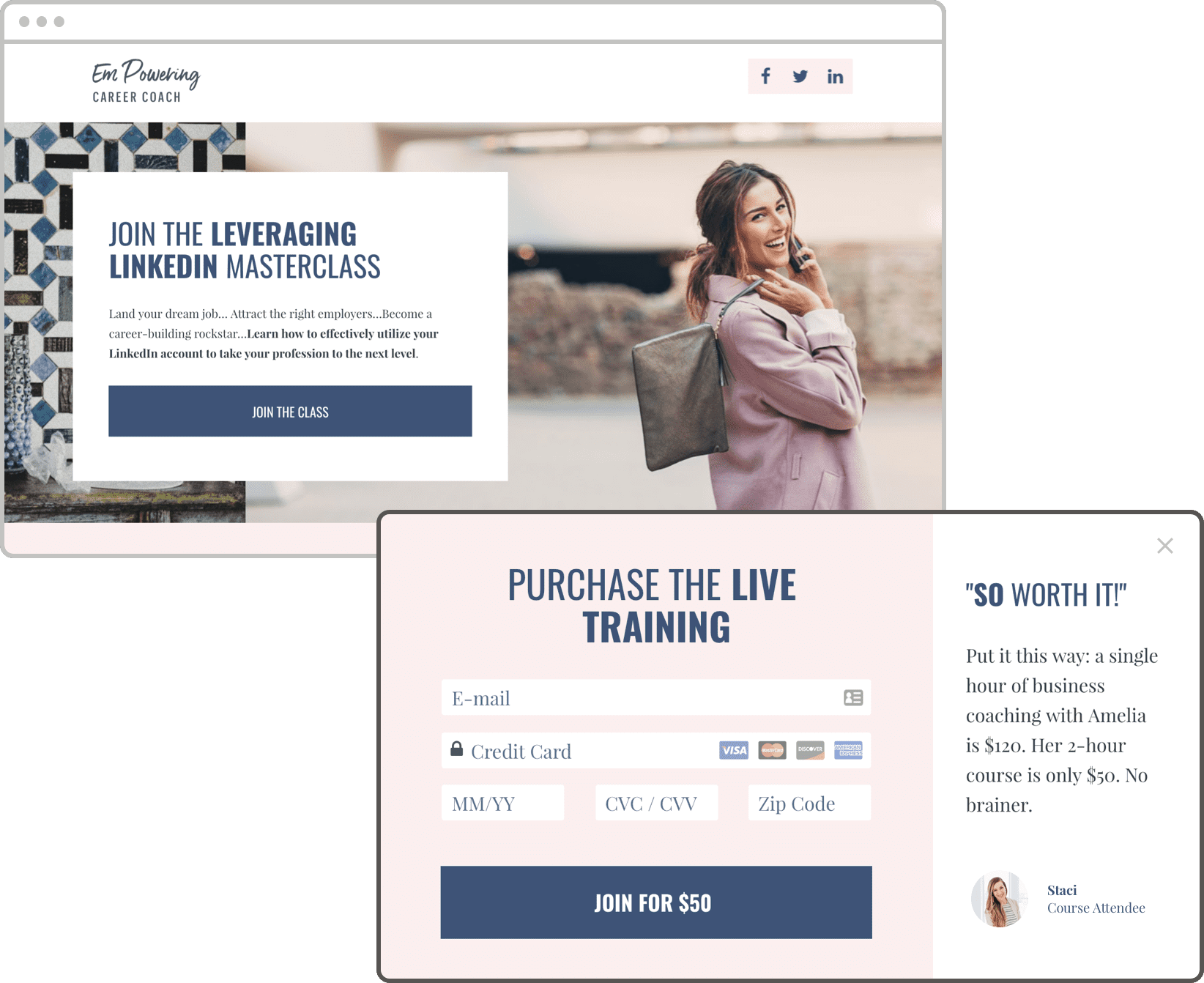
Leadpages also offers integrated sales and checkout pages via Stripe, so you can easily sell online products and services. And with 18 widgets including buttons, forms, social likes, Calendly, and countdown timers you’ll have everything you need to create a high-converting business website.
Squarespace:
Squarespace has 56 native integrations. They also offer extensions, which give you the ability to integrate apps with your website with the help of third-party tools.
One advantage Squarespace has over Leadpages is that they integrate directly with multiple payment processing tools, including Apple Pay, PayPal, Square, and Stripe. Plus, they have a blogging feature, along with a number of different blogging integrations.
Verdict:
This one really depends on your business needs. If you have a lot of apps that you’ll need to connect with your website, and you don’t want to use a third-party tool to get everything to work, Leadpages is probably your best bet.
However, if having access to multiple payment processors or blogging is important to you then you might want to go with Squarespace.
3 - Look & feel
Leadpages:
Leadpages’ has over 270 landing pages and website templates to choose from. Not only are these templates created with the latest design best practices in mind, but they’ve also been optimized for conversions.
Leadpages templates can be sorted by page type, industry, style and color. You can also search for templates based on historical conversion rates of other customers. This allows you to quickly find a template that both suits your brand and generates new leads.
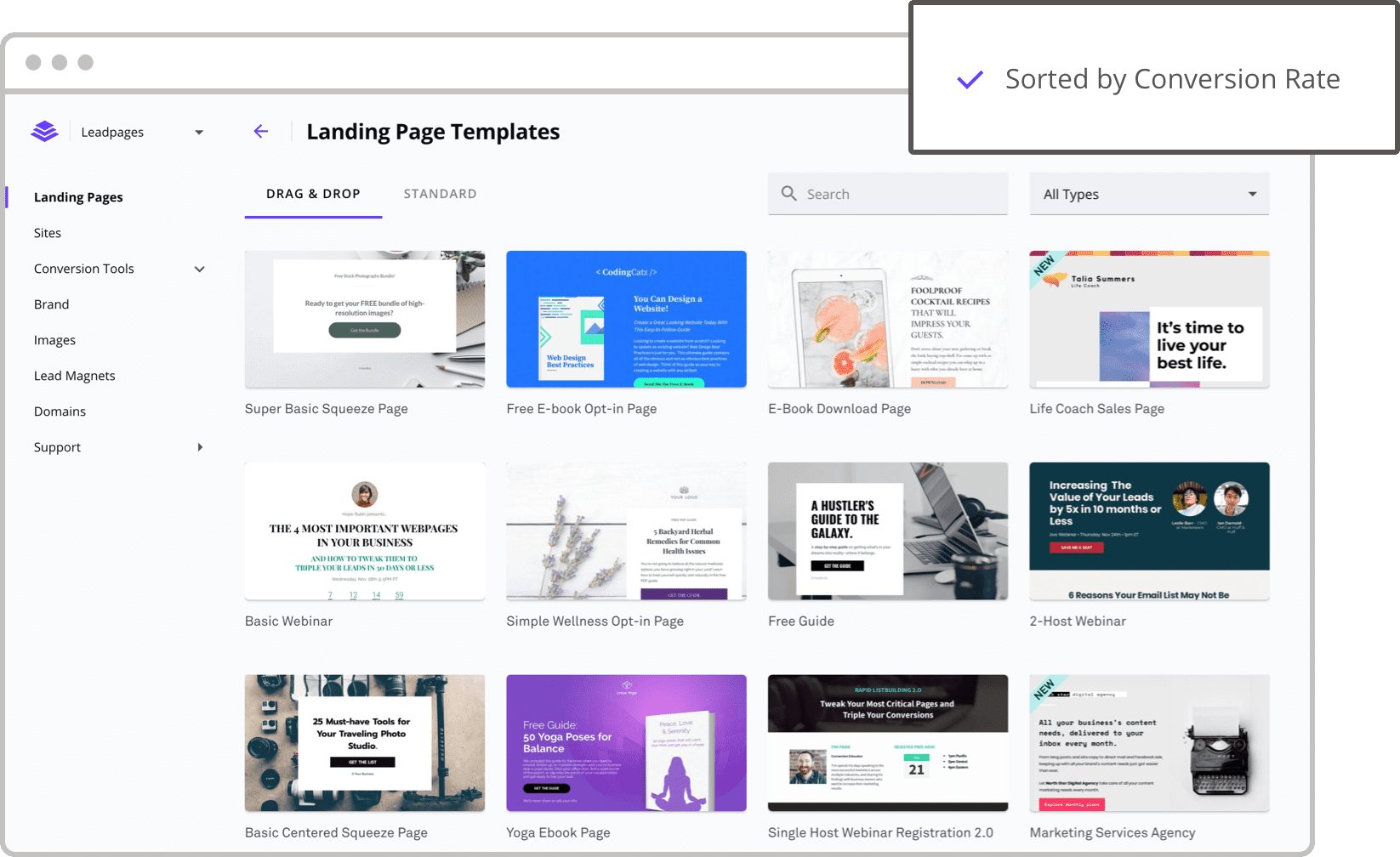
All of Leadpages’ templates are mobile responsive and display optimally on desktops, tablets, and mobile devices. Within the Drag & Drop Builder you can see exactly what your site will look like on any device. There are also device-specific display settings, which allow you to design specific sections to be shown or hidden on different screen sizes.
Squarespace:
Squarespace has a robust library of 113 website templates. They also offer a small selection of Cover Pages that can be used as landing pages, under construction pages, and 404 pages.
When searching for a template you can sort them by type and industry. Unfortunately, sorting options like color and conversion rate aren’t available.
All Squarespace templates are mobile-responsive and a multi-device preview is automatically generated for desktops, tablets, and smartphones.
Verdict:
Both platforms have a wide variety of attractive templates, but Leadpages has a slight edge due to the total number of templates they offer and their focus on conversions.
The ability to sort templates by conversion rate allows you to judge templates both on how they look and their ability to generate leads. Leadpages also offers landing pages for a wide range of applications, including squeeze pages, sales pages, event pages, 404 pages, and more.
Squarespace does offer Cover Pages, but these are short pages mostly intended more for newsletter sign-ups and under construction pages. If you need to create a longer sales page Squarespace might not be the right choice.
However, it’s worth noting that Squarespace currently offers more website templates than Leadpages.
4 - Conversion tools
Leadpages:
As the name suggests, Leadpages is designed to help you get leads for your business. So, as you’d expect, they offer a large number of conversion tools to help you achieve this.
- Alert bars: sticking to the top or bottom of your website, these text bars are perfect for promoting lead magnets, special offers, events, and more.
- Pop-ups: get the attention of your visitors as soon as they arrive on your site, or as they’re about to leave. They can also be triggered when a user clicks an image, button, or text link.
- Leadmeter: get real-time advice on how to optimize your page for conversions (currently available when creating landing pages).
As you generate leads you can review them in your Leads Library. Here you’ll find the contact information of everyone who’s opted into your email list, all in one place. Leadpages also offers analytics and A/B testing so you can fine-tune your pages and make changes based on the behavior of your website visitors.
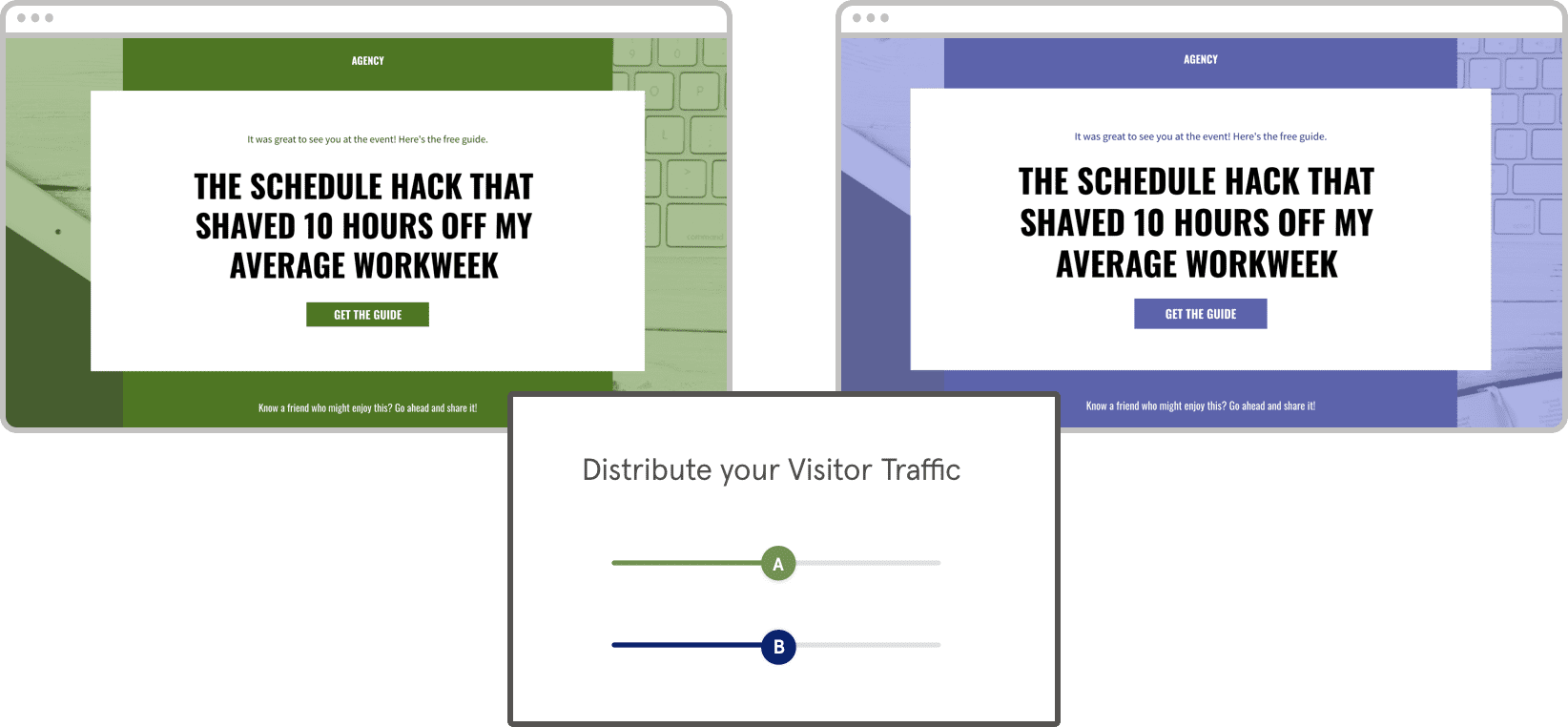
Plus, you can use the lead magnet delivery feature to send an initial welcome email with a lead magnet to new leads and customers.
Squarespace:
While not as focused on conversions as Leadpages, Squarespace still offers a fair number of tools to help you turn visitors into customers.
These include:
- Alert bars
- Pop-ups
- Real-time analytics
Squarespace doesn’t have an equivalent to the Leadmeter and they don’t support lead magnet delivery without the help of third-party tools. A/B testing can be done on the platform, but you’ll need a third-party app for this as well.
Verdict:
When it comes to conversion-optimization, Leadpages enjoys another narrow victory. With optimized landing page templates, the Leadmeter, and a whole host of conversion tools it’s hard not to choose Leadpages here.
While Squarespace supports A/B testing and lead magnet delivery, they require third-party tools. Since Leadpages offers these functionalities natively it makes the process a lot simpler.
That being said, when it comes to analytics, it’s a tie. Both platforms offer real-time analytics dashboards and integrations with Google Analytics and other third-party tools.
5 - Publishing options
Leadpages:
Leadpages offers a number of flexible publishing options. Every account comes with free hosting on a custom Leadpages subdomain (https://your-domain.lpages.co). You can also publish on a domain that you already own, a sub-domain of an existing website, or purchase a Leadpages annual subscription and receive a free domain for one year (powered by Hover).
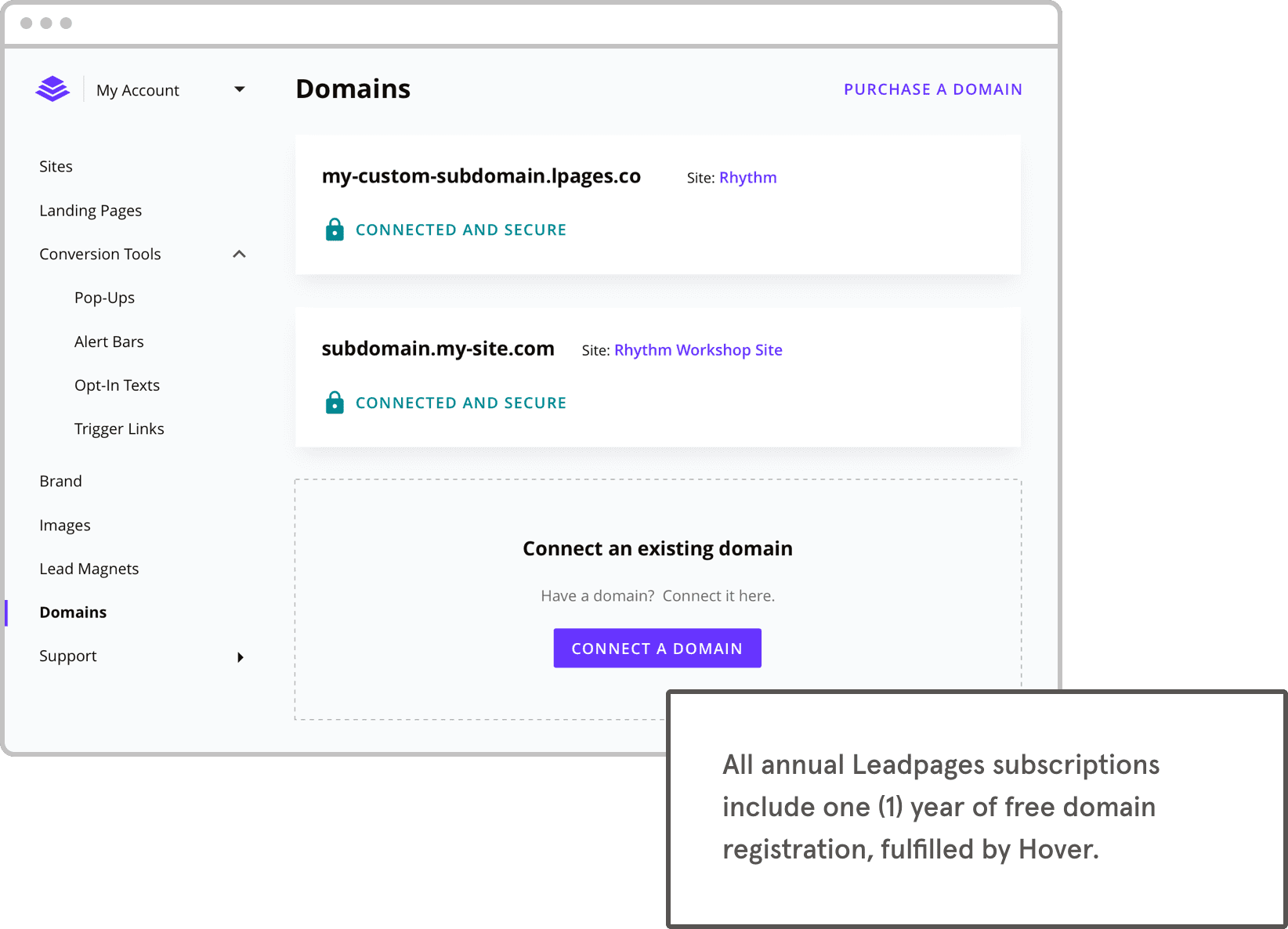
In addition, every Leadpages account includes a plugin you can use to install your landing pages, pop-ups, and alert bars on any WordPress site you own. You can even publish your page as a dynamic HTML page, which automatically updates when edits are published in Leadpages.
Leadpages also makes it easy to share completed landing pages or websites with your team or clients (at no additional cost) for their own Leadpages account.
Squarespace:
Squarespace has a few different publishing options, but they’re a little more restrictive than Leadpages.
All annual Squarespace plans include a free custom domain for one year. If you already own a domain you can transfer it to Squarespace and publish your site there. Unfortunately, there isn’t an option to publish to a free subdomain, or to a WordPress site.
Squarespace charges between $20-$70 per year for each additional year or domain.
One advantage Squarespace has is that users can set and share permissions of the site manager, administrator, content editor, billing, or store manager—whereas Leadpages accounts are managed by a single login.
Verdict:
It depends on your needs.
Leadpages offers more publishing options. If you don’t want to pay for a custom domain you can publish your site to a free Leadpages subdomain. You can also use the Leadpages plugin to publish your landing pages, pop-ups, and alert bars to a WordPress site. So, if you’re looking for more flexibility when it comes to publishing, Leadpages is better for you.
However, Squarespace offers multi user permissions within a single account, which is useful if you’re working in a large team and you don’t want to rely on a single login.
6 - Traffic & advertising
Leadpages:
After you build your website you’ll need to drive traffic to your pages. With Leadpages, you can harness the power of a streamlined analytics dashboard and real-time data to track your traffic and make changes accordingly. You’ll also get unlimited traffic and leads so you don’t need to worry about paying more as your site grows.
Leadpages makes search engine optimization easy. Use the SEO settings and previews to set the meta title, keywords, and description of any page to help with all-important Google rankings. Adding H1, H2, H3, and alt-text tags to your content is intuitive.
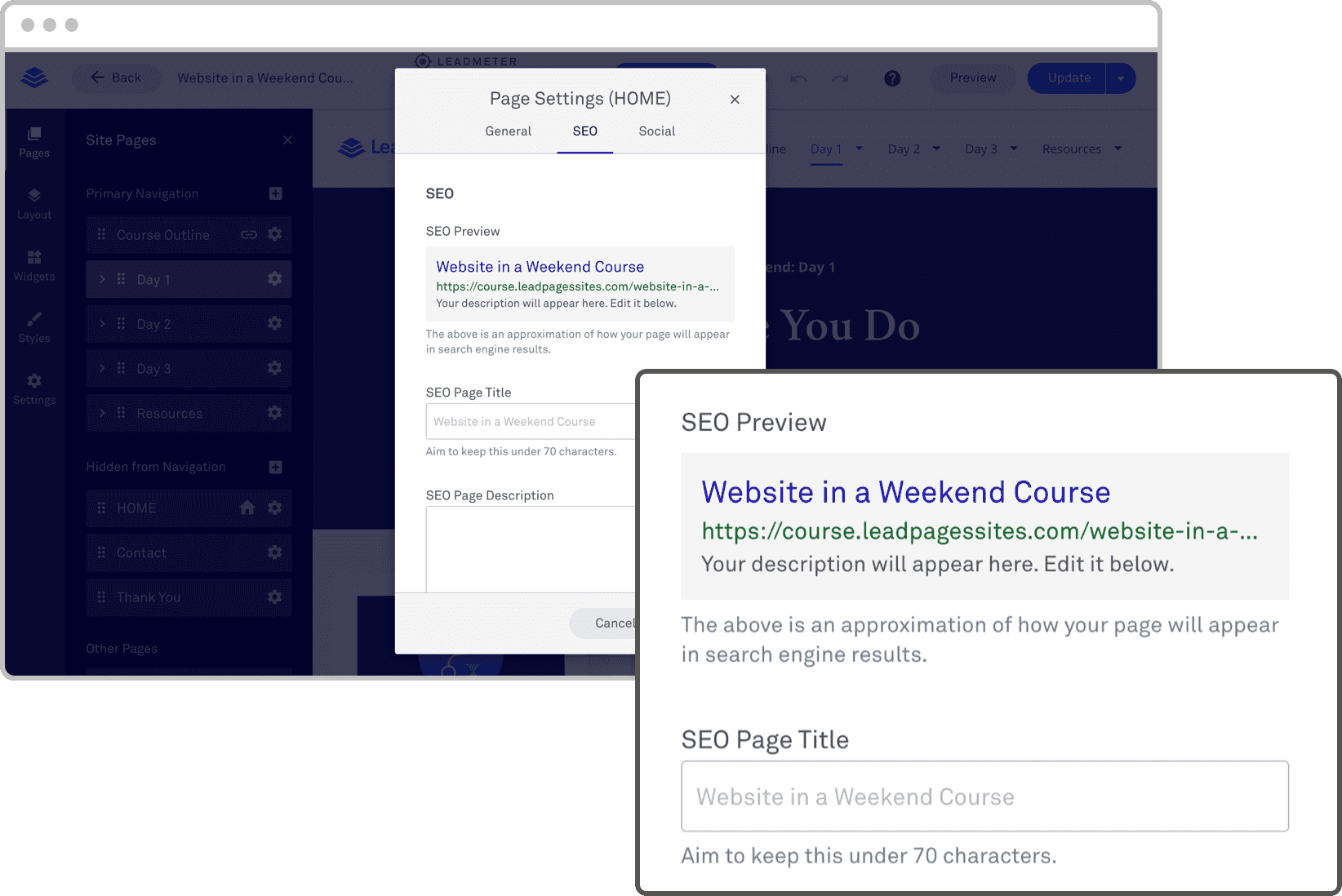
Plus, Leadpages features industry-leading page load speeds (faster by 2.4 seconds on average). Not only does this boost your SEO, but it also lowers your bounce rate and increases conversions.

Squarespace:
Squarespace’s analytics give you plenty of data that you can use to track your traffic and results. Similar to Leadpages, you’ll also enjoy unlimited traffic and leads on this platform.
Optimizing your pages for SEO is easy, as you can edit your meta titles, keywords, and descriptions within the builder.
When it comes to page load speed, Squarespace has Accelerated Mobile Pages (AMP pages) to help mobile web and landing pages load faster.
Verdict:
It’s a tie! Neither of the platforms has a limit on leads and traffic, which is great news for a growing business.
Both have similar analytics tools and integrate with Google Analytics and other third-party services, so after you hit “publish” you can see in real-time who’s coming to your page, from where, and how long they’re staying.
Google-friendliness is key if you want to be successful online, and both offer behind-the-scenes SEO tools such as site mapping, SSL certificates, automatic tagging, and built-in meta tags to make organic growth easier. Engineers at both platforms have made their page load speeds very fast.
7 - Value
Leadpages:
Determining value isn’t as simple as seeing who offers the cheaper price. It’s about what you get for that price. And Leadpages certainly offers a lot.
With Leadpages, you get a landing page and website builder, access to over 270 templates, a long list of conversion tools, analytics, and more.
There are three plans to choose from:
- The Standard plan starts at $37/month (when paid annually) and offers everything mentioned above plus one website, unlimited landing pages, free hosting, and all basic features.
- The Pro plan costs $74/month (when paid annually) and offers everything mentioned above plus three websites, unlimited A/B testing, and online sales and payments with Stripe.
- Enterprise customers looking for even more features can contact Leadpages about the Advanced plan. This includes extra websites, advanced integrations, five sub-accounts, and top-tier customer support.
- Customers save 25% on average when they choose an annual plan.
Squarespace:
Squarespace offers four different plans for you to choose from:
- The Personal Plan is $14/month (when paid annually) and includes a free domain, unlimited bandwidth, basic website metrics, and Squarespace extensions.
- The Business Plan is $23/month (when paid annually) and offers everything mentioned above plus premium integrations, advanced website analytics, ecommerce tools, alert bars, and pop-ups.
- The Basic Commerce Plan is $27/month (when paid annually) and offers everything mentioned above plus ecommerce analytics, point of sale, and merchandising tools.
- The Advanced Commerce Plan is $49/month (when paid annually) and offers everything mentioned above plus abandoned cart recovery and advanced shipping and discounts.
Verdict:
Squarespace’s plans are more affordable for the most part. However, they lack some key features that Leadpages offers.
With a dedicated landing page builder and more conversion tools, Leadpages is the right choice if you’re looking to collect leads, grow your email list, and find new customers. A higher conversion rate means more sales, which over time will make up the difference in price.
Still, if you’re looking for an inexpensive way to get your business online Squarespace is a solid choice.
The Final Verdict
Choosing between Leadpages and Squarespace is really dependent on your audience, goals, and type of business.
